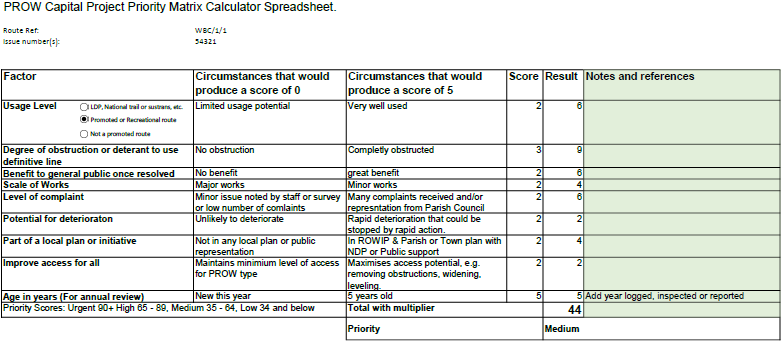Rights of Way - Capital Projects
What happens to issues that have been reported to the Rights of Way team? How we asses them and prioritise action

The following is a description of what happens after you report a defect with a Public Rights of Way.
We make an initial assessment of urgency based on your description of the issue, the location of the issue, the route designation (footpath, bridleway or byway) and how busy the route is.
We then arrange to inspect the issue. If we think it might be potentially dangerous, we will make a site visit as soon as possible - possibly the same day. Less urgent issues might be inspected several weeks after being reported.
Once inspected, we use a Priority Matrix to assess the urgency in the works plan (see below).

Set of standards
This Matrix provides a criteria to assess all routes to a set of standards.
Usage
It prioritises according to importance on a national or district level. Important routes have a higher weighting. Usage weighting is:
- Times 2 for standard Public Rights of Way.
- Times 3 for Active Travel routes. Promoted or Recreational routes within the district.
- Times 4 for Routes to Schools. National Routes. LDP or Long Distance routes. National Trails. Sustrans routes and other nationally important routes.
If a route is not used because, for example, it is obstructed, we estimate its potential usage levels if the route was in good condition, not blocked.
Physical considerations
- Will little or no action lead to a rapid degradation?
- How obstructed is the route?
- Size of the task to remedy. Alternatively, what is required to improve it to a better standard, for example Access for All, or upgrading from footpath to bridleway.
Public benefit and local policies
- Will the improvement be of benefit to the public?
- Is the route part of a Neighbourhood Plan?
- Is there a local initiative to improve the route?
- Would improvement or other works reflect the aims of the Rights of Way Improvement Plan (ROWIP)?
- Will it improve Access for All?
Level of complaint
Has this been reported by multiple sources? That is, for example, reported by multiple individuals and/or representative organisations.
Age of issue
This is to ensure that an issue of lower priority will raise in level or priority if it has been an issue for some time. This ensures that lower priority routes will not remain at the bottom of the priority list forever. Please note that the rating is not limited to 5, that is an example. If the issue is 10 years old, then the score is 10. It is worth noting that records are consulted, and if the issue was recorded for some reason at an earlier date, that is the start time, not the time of your submission.
A score
This matrix then produces a score, with the following priorities:
- Urgent. Anything that is Urgent will be attended to immediately. This does not always result in immediate resolution. See below for considerations before action.
- High. This will be added to the case list to be dealt with in the following financial year, as funding allows.
- Medium. Added to the case list to be dealt with in the next 2-5 years, as funding allows.
- Low. Added to the case list. These are reviewed annually and can change in priority due to changes in local policies, plans or desires. Plus the age will naturally raise the priority.
Considerations before action
There might be many tasks to complete before being able to resolve the issue, including, but not limited to:
- Establishing responsibility.
- Establishing ownership.
- Seeking permission from landowners, and working with landowners to achieve an agreeable result to all concerned.
- Physical constraints. Access might be difficult, and require careful planning. Underground services and other such considerations need to be accounted for.
- Agreeing with users and user groups, parish and town councils and landowners the best solution for all interested parties.
- Finding a solution that is good value for money for the tax payer. This does not always mean the least expensive option, but the one that produces the best return over the longest period of time. This might produce a major project, or a series of small, and discrete interventions. (The latter might be a period of small scale, but relatively intense maintenance, for example, works to improve drainage, or tackle problematic vegetation, like a patch of nettles.)
- Funding. Resources are limited, so sometimes funding a project might require careful planning. We work closely wherever possible with parish and town councils, as they can sometimes access grant funding. Similarly, other organisations and interest groups may have other sources of funding. We also apply for capital funding for a number of these projects.




